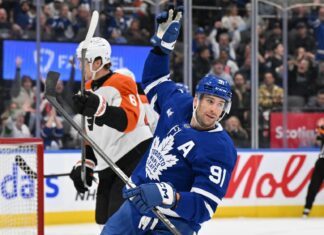In our ongoing evaluation of the Maple Leafs’ under-contract players, we round out the forward group by assessing Pontus Holmberg and Ryan Reaves’ 2023-24 seasons and their roles moving forward.
Catch up on my previous four pieces in the Offseason Evaluations series below:
- Offseason Evaluations, Part 1: Auston Matthews & William Nylander
- Offseason Evaluations, Part 2: Mitch Marner & John Tavares
- Offseason Evaluations, Part 3: David Kampf & Calle Jarnkrok
- Offseason Evaluations, Part 4: Bobby McMann & Matthew Knies
Pontus Holmberg
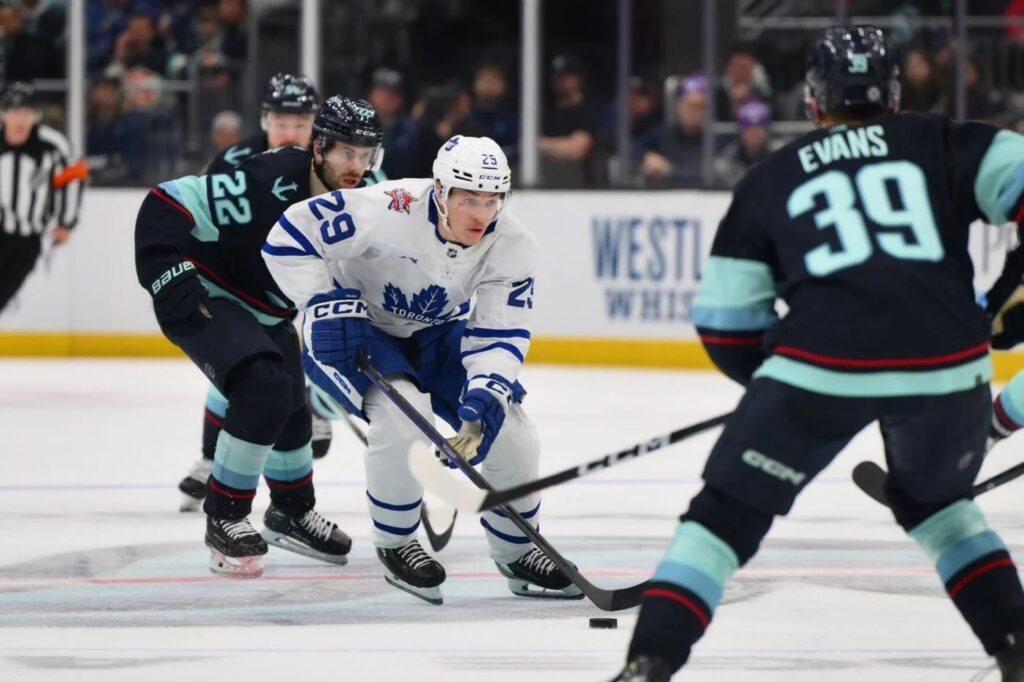
| Pontus Holmberg | |
|---|---|
| 2023-24 Production | 7 goals and 17 points in 54 games (11:34 per game) |
| 5v5 Results | 50.75 CF% | 53.21 xGF% | 30 goals for, 21 goals against |
| Contract Status | One year remaining at $800,000 |
Holmberg entered the season looking to build on a promising rookie campaign in which he recorded 13 points in 37 games but hit a rookie wall and was out of the lineup by the playoffs. However, any momentum he built in his first season didn’t initially carry over into 2023-24.
Holmberg produced a very vanilla preseason showing; he wasn’t necessarily bad, but he didn’t do anything of note to stand out or make a difference. As a result, he started the season with the Marlies, while Fraser Minten was named the opening night 3C. That trial didn’t last long — Minten played just four games, and Holmberg was back with the Leafs before October ended, featuring in five games in the opening month of the season.
When Holmberg was in the lineup, he wasn’t exactly placed in a position to succeed. Playing largely in between Noah Gregor and Ryan Reaves, Holmberg went pointless and played under nine minutes in four of the five games. After two more pointless games to start November, Holmberg was sent down and Nick Robertson was recalled.
It wasn’t until mid-December that Holmberg returned to the Leafs’ lineup – due to injury situations – and even though the Leafs ran over the Penguins and he collected his first point of the season, he didn’t play again for two weeks.
Holmberg didn’t look back once he got his next opportunity. In 2024, he played 45 games, scored seven goals and 16 points, and averaged 12:05 per night. January was by far his most productive month, with seven points in 12 games. Not coincidentally, he spent much of his time on the wing with Matthews and Marner and also saw some time alongside Tavares and Nylander. With Matthews and Marner, Holmberg won those minutes 4-1 in goals with an edge in scoring chances and a slight deficit in shot attempts.
Holmberg showed well as a worker on the top line, recognizing it was his job to be the first man in on the forecheck and go to the net. However, he struggled with his shooting. He can’t make goalies pay from distance, and there were several good scoring chances that he simply fanned on. He performed well in spot duty up the lineup, but the lack of a shot and dangerous offensive game overall didn’t make it a viable long-term solution.
When February rolled around, Holmberg moved down the lineup and his production dried up as a result (three points in 12 games). However, while he wasn’t producing offense, he formed a credible fourth line alongside David Kampf and Ryan Reaves. The trio played a little under 60 minutes together at five-on-five this past season and came out ahead in every category while taking more defensive zone than offensive zone faceoffs. They were on the positive side of the ledger in shot attempts, carried over 70 percent in expected goals (!), and won the actual goals 3-1. Holmberg was a driving force of the line; his speed up and down the wall stands out, and he’s able to get the puck out of his own zone, through the neutral zone, and into the offensive end.
While his finishing is an issue regarding his credibility as a consistent top-six forward, Holmberg is clearly fast and effective enough with the puck to advance it into the offensive zone and keep it there. He is strong on the wall and has some sneaky skill in his game, as highlighted by a slippery goal in Vegas.
As the roster evolved through the trade deadline and the injury situations, Holmberg moved up to the third line and played center, with Max Domi shifting to the top-line wing spot. The Leafs really lacked center options, so it was a bit of an arranged marriage, and the results played out accordingly in the playoffs.
In the Boston series, Holmberg was tasked with centering the third line. He didn’t play poorly, but he went pointless in seven games and his one highlight of note was grappling with Brad Marchand. As we’ve repeated seemingly every spring, it’s hard to win a competitive playoff series when a full forward line doesn’t score at all. Holmberg also won just 46.3 percent of his faceoffs, although it was a near four percent improvement over his first season, so it would help his cause if he can continue trending up on the dot.
Holmberg also flashed potential as a penalty killer at times. His speed helps him close passing lanes, and he has good instincts when reading the play. Again, his speed is an asset, and he’s strong on his stick when working the walls. But he will need to work on his shot and playmaking with the puck if he’s ever going to stick higher in the lineup.
At an 800K salary, it’s easy to keep Holmberg, as he’s cheap and can clearly take a shift in the NHL. The fourth line was arguably its best with him on the left wing, and I would argue Holmberg was the biggest reason why his line with Reaves and Kampf was so solid.
One of the questions for the Leafs to sort out: Where do they project Holmberg long-term? He’s a fairly effective winger skating up and down the wall. At center, he was far less productive and impactful, so the answer might seem obvious, but there are two things to note: They might not be able to bring in much competition, and developing a center is far more beneficial than another winger, which is always easy to find. The fact that Holmberg can already play in the middle in some capacity might be worth investing in further.
In an ideal world, the Leafs can bring in another center of note, start Holmberg on the wing, and at some point during the season, he’ll get another look in the middle due to injury, at which point we’ll assess his ability to handle it. It’s also possible Holmberg can be a cheap 4C to start the season, but I’ll point out that while the cap savings are notable, the deployment would be different and could create a ripple effect.
There’s no real evidence Holmberg can handle tough checking assignments, which Kampf did well for two years on a real checking line before this past season. There is also not much evidence to suggest Holmberg can take faceoffs well or that he can be part of a successful penalty-killing unit. Kampf has proven all of those things, and while it’s sometimes shrugged off, the Leafs as a whole shrugged off acquiring proper penalty killers last summer. Their penalty kill was a mess all season as a result.
I’d rather see the Leafs carry 13 forwards, with Kampf, Holmberg, Dewar, and Reaves making up the final four. They can rotate and evaluate as the season progresses.
Ryan Reaves

| Ryan Reaves | |
|---|---|
| 2023-24 Production | 4 goals and 6 points in 49 games (8:07 per game) |
| 5v5 Results | 47.55 CF% | 48.92 xGF% | 10 goals for, 22 goals against |
| Contract Status | Two years remaining at $1.35 million AAV |
Reaves entered the 2023-24 season with a lot of noise around him, some of which he created himself. You may recall Reaves’ offseason comments about Radko Gudas celebrating in Joseph Woll’s face to end the Florida series, suggesting it wouldn’t happen under his watch. In the first game of the season, Reaves came out for player introductions flexing and then fought Arber Xhekaj.
That was the extent of the Reaves highlights early on, though, as he was -11 with one point (a goal) through the first two months of the season (16 games). Plus-minus is generally a flawed stat, but -11 through two months with only one point is hard to overlook. When I went through most of those goals, they had little or nothing to do with Reaves. It’s worth noting there was some very bad luck at play.
Either way, it pushed Reaves out of the lineup. Early on, the team was generally playing poor hockey and looking for solutions, one of which was fixing the fourth line. Reaves played just five games in December and one in January.
Reaves battled an injury for part of that time, but before finally rejoining the lineup, he noted in a media availability that he was ready to play for a couple of weeks before he dressed. When a Calle Jarnkrok injury opened the door, Reaves played in a late January game against the Jets and performed well. His line was energetic, cycled well, and Reaves scored.
For the rest of the season, Reaves was effective as a fourth-liner. He won the territorial battle, coming out in the black in shot attempts and expected goals despite starting in the defensive zone more than anywhere else. In actual goals, he was technically outscored, but it was only by a margin of one (8-9 total). As noted, it was a legitimately solid fourth line when Holmberg moved down to the fourth-line left-wing spot.
As the season progressed, Reaves was also far more physically active. In his final 28 games, he dropped the gloves five times. His game at five-on-five was simple but effective. He got pucks in deep, forechecked well, and worked the walls to keep it deep. He produced some real stand-out moments against Florida and Tampa Bay down the stretch by setting a physical tone.
It was interesting to hear Reaves note that he used his time off as a mini-training camp to work on his game and build his confidence. I couldn’t help but think he was faster down the stretch, and he should come into camp this season as close to that level as possible rather than taking half the season and sitting for nearly a month and a half to reach it.
In the playoffs, the fourth line was fairly effective for the Leafs, controlling play and giving the team a real momentum boost. At one point, Jim Montgomery line matched against them in response. At the same time, Reaves also committed a few critical turnovers that ended up in the Leafs’ net, and he was scratched as the series went on.
Fans generally know what Reaves is at this point, and there were times throughout the season when his energy and physicality were infectious throughout the group. At the same time, he was a liability in the first half of the season and is now 37 years old. If he can generally give the team his second-half effort and level of play, he can serve a useful role. As noted above, ideally, he’s part of a fourth-line rotation.
Reaves isn’t really an 82-game player at this rate based on his age and physical brand, but he can be an effective veteran who plays a simple game and provides a spark.
Next up in the Offseason Evaluations series: The Defense








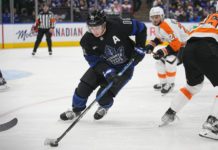



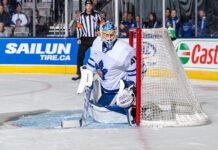


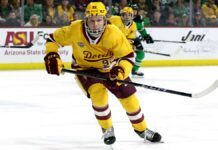





![Two Down, Two to Go for the Maple Leafs – MLHS Podcast EP91 [Now with Video]](https://mapleleafshotstove.com/wp-content/uploads/2025/04/maxresdefault-3-218x150.jpg)

